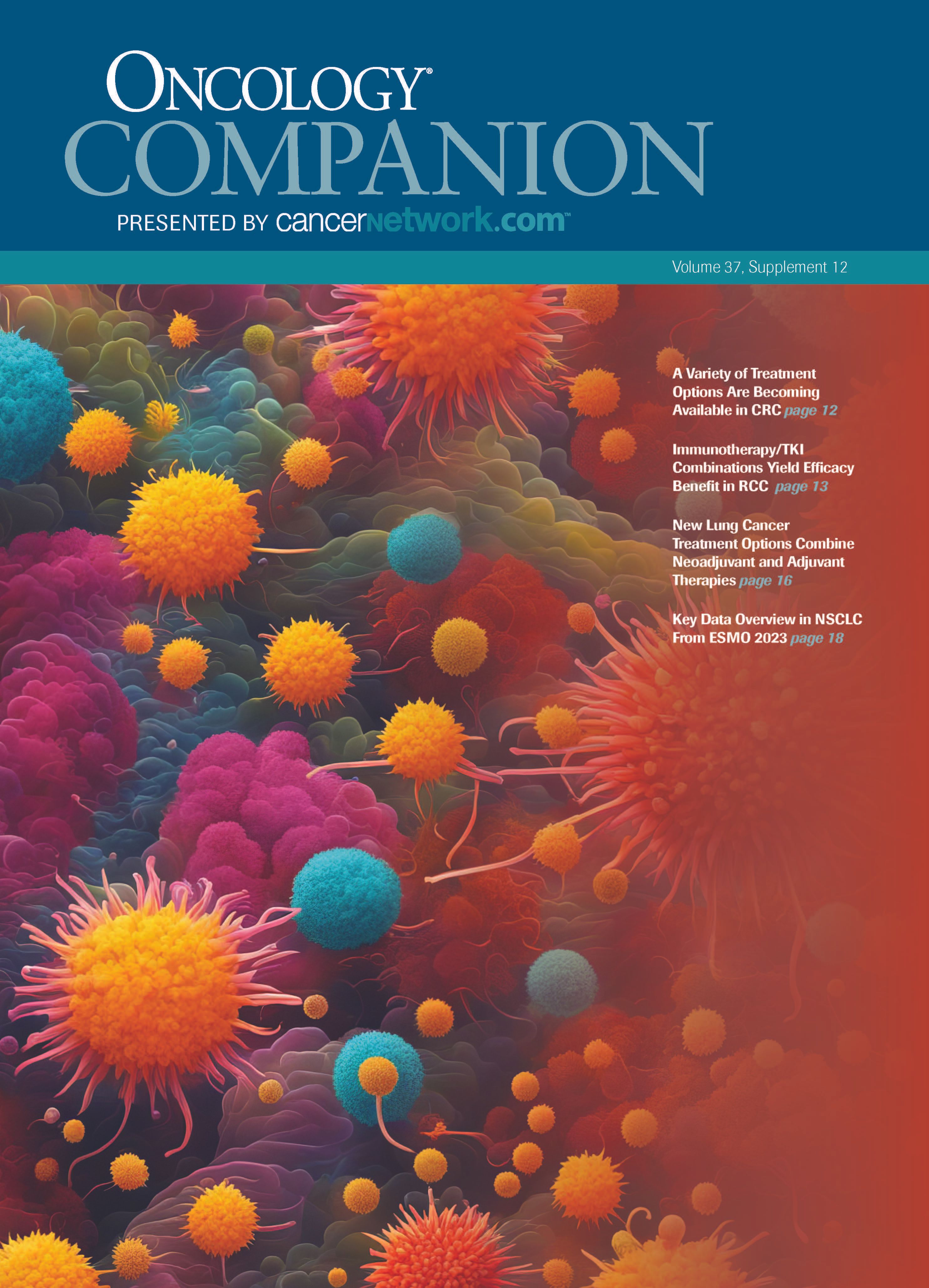Key Data Overview in NSCLC From ESMO 2023
During the European Society for Medical Oncology 2023, experts discussed updated results in key trials across the lung cancer space.
The expert panel.

Sabari’s Take on TROPION-Lung05
A total of 137 patients with previously treated non–small cell lung cancer (NSCLC) were enrolled in the phase 2 TROPION-Lung05 trial (NCT04484142).1 Patients were given datopotamab deruxtecan (Dato-DXd) at 6 mg/kg every 21 days.
The primary end point was confirmed objective response rate (ORR) by blinded independent central review (BICR). Secondary end points were the duration of response (DOR) and disease control rate by BICR. To be eligible for treatment, patients must have EGFR, ALK, ROS1, TRK, MET exon 14, or RET alterations and received 1 line of previous therapy.
The median patient age was 61.0 years, and 71.5% of patients had 3 or more previous lines of therapy. Therapy discontinuation occurred in 84.5% of patients, 63.5% had disease progression, and 49.6% had died. The median duration of treatment was 15.2 months.
The confirmed ORR was 35.8% (95% CI, 27.8%-44.4%), with 32.8% having a partial response, and 2.9% having a complete response. The confirmed ORR for patients with an EGFR mutation was 43.6%. The disease control rate was 89.8% and the median DOR was 7.0 months.
Grade 3 or higher treatment-emergent adverse effects (TEAEs) occurred in 47.4% of patients, and 24.8% had serious TEAEs. Dose reductions due to TEAEs occurred in 21.9% of patients, 9.5% had drug discontinuation, and 1.5% of patients died from TEAEs. Of note, grade 1 or 2 adjudicated drug-related interstitial lung disease occurred in 2.9% of patients, and 0.7% had grade 3 or higher TEAEs.
“Dato-DXd showed encouraging antitumor activity with a clinically meaningful and durable response in heavily pretreated patients with NSCLC with actionable genomic alterations. The safety profile was manageable and consistent with prior safety observed with Dato-DXd,” Sabari said.
Patel Reviews Amivantamab Use in EGFR-positive Exon 20 NSCLC
A total of 308 patients were enrolled in the phase 3 PAPILLON study (NCT04538664).2 Patients with EGFR-psotive exon 20 advanced NSCLC were treated with amivantamab-vmjw (Rybrevant) plus carboplatin and pemetrexed.
Patients were randomly assigned 1:1 to receive the combination treatment or chemotherapy alone. The primary end point was progression-free survival (PFS), and secondary end points were PFS after the first subsequent therapy (PFS2), overall survival (OS), and safety. If patients progressed on treatment, they were allowed to cross over to the amivantamab arm.
Between arms, the median patient age was 61 vs 62 years, 56% vs 60% were women, 64% vs 59% were Asian, and 23% vs 23% had a history of brain metastases. The median follow-up was 14.9 months.
The median PFS in the amivantamab arm was 11.4 months (95% CI, 9.8-13.7) vs 6.7 months (95% CI, 5.6-7.3) in the chemotherapy arm (HR, 0.40; 95% CI, 0.30-0.53; P < .001). At 18 months, the PFS rate was 31% in the amivantamab arm vs 3% in the chemotherapy arm. The ORR was 73% (95% CI, 65%-80%) in the amivantamab arm vs 47% (95% CI, 39%-56%) in the chemotherapy arm. For the amivantamab arm, the median PFS2 was not evaluable vs 17.2 months in the chemotherapy arm (HR, 0.49; 95% CI, 0.32-0.76; P = .001).
The interim OS analysis had 33% maturity, with a favorable trend toward the amivantamab arm (HR, 0.67; 95% CI, 0.42-1.09; P = .106). For patients receiving chemotherapy alone, 66% who had disease progression received second-line amivantamab.
TEAEs occurred in 40% or more of patients and the most common in the combination arms were neutropenia, paronychia, rash, anemia, infusion-related reactions, and hypoalbuminemia. Amivantamab was discontinued in 7% of patients due to AEs.
“When thinking about this combination regimen, thinking about dose reductions of chemotherapy to maximize the dose, duration, and intensity of amivantamab will be key. Supportive care measures involving our dermatology colleagues will be important to ensure that patients are able to remain on therapy as well tolerated as
possible,” Patel said.
Spira on Efficacy Response in MARIPOSA-2 Trial
Amivantamab plus chemotherapy with or without lazertinib (Leclaza) vs chemotherapy alone was used to treat patients with locally advanced or metastatic NSCLC harboring EGFR exon 19 deletions or L858R substitutions.3 The phase 3 MARIPOSA-2 trial (NCT04988295) randomly assigned patients 2:2:1.
Amivantamab was given at 1400 mg for the first 4 weeks, then 1750 mg every 3 weeks starting at cycle 3. Lazertinib was given at 240 mg daily after completion of carboplatin. Chemotherapy treatment consisted of carboplatin at area under the curve of 5 for the first 4 cycles, then pemetrexed at 500 mg/m2 until progressive disease. Primary end points were PFS by BICR; secondary end points were ORR, DOR, OS, intracranial PFS, time to subsequent therapy, and safety.
Patients had a median age of 61 years, 62 years, and 62 years, respectively. Most were women (64% vs 62% vs 60%), had an ECOG performance status of 1 (65% vs 58% vs 62%), and had EGFR exon 19 deletions (63% vs 68% vs 70%) in the amivantamab plus lazertinib, amivantamab plus chemotherapy, and chemotherapy arms, respectively.
The median PFS by BICR in the amivantamab plus lazertinib group was
8.3 months, 6.3 months in the amivantamab plus chemotherapy group, and
4.2 months in the chemotherapy group. The 6-month PFS rates between each group, respectively, were 59%, 51%, and 30%; at 12 months they were 37%, 22%, and 13%. Investigator-assessed PFS was 8.3 months, 8.2 months, and 4.2 months in the amivantamab plus lazertinib, amivantamab plus chemotherapy, and chemotherapy arms, respectively.
All subgroups saw a PFS benefit when amivantamab was added to chemotherapy vs chemotherapy alone. Patients with L858R substitutions (HR, 0.30; 95% CI, 0.17-0.54), those younger than 65 years (HR, 0.44; 95% CI, 0.31-0.64), and those with an ECOG performance status of 0 (HR, 0.44; 95% CI, 0.28-0.69) saw the most benefit.
The ORR was 63%, 64%, and 36%, and there were complete response rates of 2%, 2%, and 0.4% in the amivantamab plus lazertinib, amivantamab plus chemotherapy, and chemotherapy arms, respectively. Additionally, the median DOR was 9.4 months (95% CI, 6.9-not estimable [NE]), 6.9 months (95% CI, 5.5-NE), and 5.6 months (95% CI, 4.2-9.6), respectively.
Grade 3 or higher AEs in the amivantamab plus lazertinib arm were neutropenia (55%), thrombocytopenia (37%), and leukopenia (27%); in the amivantamab plus chemotherapy arm they were neutropenia (45%), leukopenia (20%), and thrombocytopenia (15%); and in the chemotherapy arm they were neutropenia (21%), thrombocytopenia (9%), and anemia (9%).
“Amivantamab/chemotherapy and amivantamab/lazertinib/chemotherapy improved PFS, ORR, and intracranial PFS vs chemotherapy alone in EGFR-mutated advanced NSCLC after progression on osimertinib [Tagrisso]. Amivantamab plus chemotherapy and amivantamab plus lazertinib and chemotherapy may represent a new standard of care,” Spira said.
References
- Paz-Ares L, Ahn MJ, Lisberg AE, et al. 1314MO TROPION-Lung05: datopotamab deruxtecan (Dato-DXd) in previously treated non–small cell lung cancer (NSCLC) with actionable genomic alterations (AGAs). Ann Oncol. 2023;34(suppl 2):S755-S756. doi:10.1016/j.annonc.2023.09.2348
- Girard N, Park K, Tang K, et al. LBA5 Amivantamab plus chemotherapy vs chemotherapy as first-line treatment in EGFR exon 20 insertion-mutated advanced non–small cell lung cancer (NSCLC): primary results from PAPILLON, a randomized phase III global study. Ann Oncol. 2023;34(suppl 2):S1304. doi:10.1016/j.annonc.2023.10.060
- Passaro A, Cho BC, Wang Y, et al. LBA15 Amivantamab plus chemotherapy (with or without lazertinib) vs chemotherapy in EGFR-mutated advanced NSCLC after progression on osimertinib: MARIPOSA-2, a phase III, global, randomized, controlled trial. Ann Oncol. 2023;34(suppl 2):S1307. doi:10.1016/j.annonc.2023.10.063
